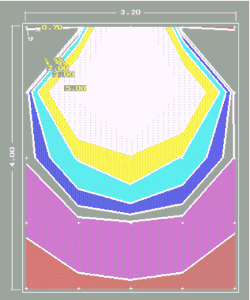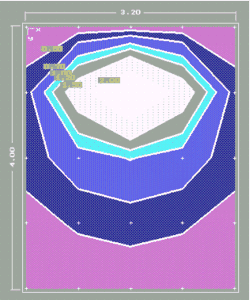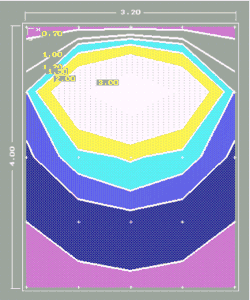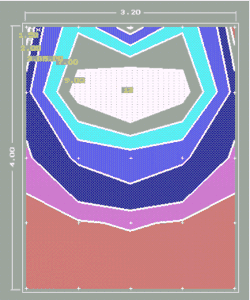
Assessment of daylight in a living room with skylights
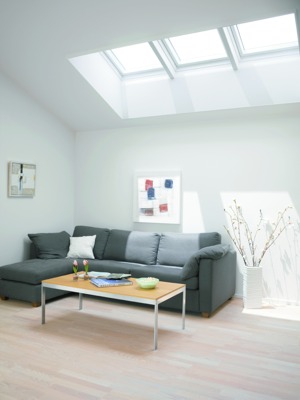 |
Roof windows, as a construction element, have become popular mainly in residential buildings, but they are also increasingly used in public utility buildings. The advantages of roof windows are evident. Roof windows do not require demanding interventions in the load-bearing structure of the roof and do not alter the architectural appearance of the building significantly, which is especially advantageous during the reconstruction of older buildings and historically protected structures.
Roof windows allow daylight to enter the room from above, which can be an advantage, especially in urban areas and where vertical windows are shaded by external obstacles. In such cases, rooms with vertical windows are illuminated largely by light that does not come directly from the sky but is reflected from the facades of opposite buildings, the terrain, and surrounding obstacles. With roof windows, there is an opportunity to utilize sky light across their entire surface.
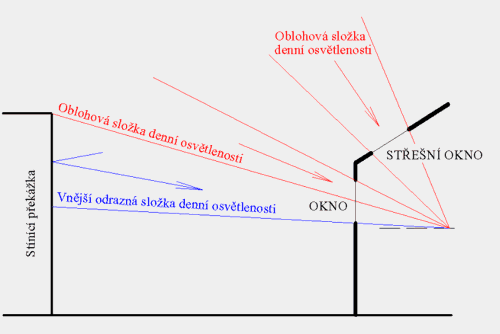 |
The utilization of sky light at windows also depends on the slope of the glazed surface. In Figure 2, an example is shown comparing the effectiveness of sky light utilization (value in %) at windows installed at various angles from 90° (vertical window) to 0° (horizontal installation) - determined according to [1].
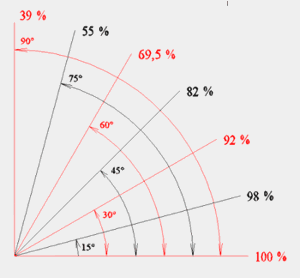 |
- the minimum daylight factor must be equal to at least D=1.5 % at all control points on the reference plane in the functionally defined part of the room with the required daylighting for the expected visual task,
- for spaces with top lighting, the average value of the daylight factor calculated from all values on the reference plane should not be less than D=5 %.
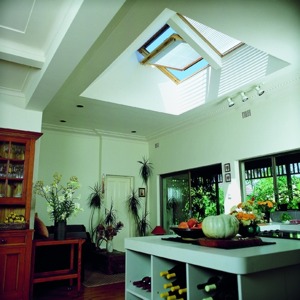 |
Furthermore, sufficient uniformity of daylighting is also required, which is defined as the ratio between the minimum and maximum value of the daylight factor at the assessed working plane. For visual task class IV, the uniformity of daylighting should not be less than 0.2. For comparison, the uniformity value defined as the ratio between the average and maximum value of the daylight factor in the assessed space can also be listed.
This room was assessed for daylighting in the following variants:
- VARIANT I: Room illuminated by a VELUX roof window measuring 1140 mm x 1400 mm, sill height 900 mm. The window is placed on a roof slope of 45°.
- VARIANT II: Room illuminated by a vertical window in the facade, window dimensions 1140 mm x 1400 mm, sill height 900 mm.
- VARIANT III: Room illuminated by two roof windows (roof slope 45°).
- VARIANT IV: Room illuminated by two vertical windows in the facade.
The calculations of the daylight factor were performed with the following input data:
- ceiling reflectance p=0.70, wall reflectance p=0.55, floor reflectance p=0.30, window reveal reflectance p=0.70, surrounding terrain reflectance p=0.10,
- light transmittance of the window glazing (insulating double glazing t=0.80),
- pollution factor of the window from the inside tz1=0.90, from the outside tz2=0.80.
Tab. 1: Comparison of daylighting in a room with a roof window and with a vertical window:
|
VARIANT I |
VARIANT II
|
||
|
Roof window |
Window in the facade |
||
|
Window dimensions 1140 mm x 1400 mm, sill height 900 mm |
|||
|
|
||
|
Total daylight factor D=Ds+Di+De [%] |
|||
|
Minimum Dmin = 0.93 % Maximum Dmax = 11.38 % Average Davg = 4.12 % |
Minimum Dmin = 0.54 % Maximum Dmax = 2.81 % Average Davg = 1.32 % |
||
|
Sky component Ds [%] |
|||
|
Minimum Dmin = 0.39 % Maximum Dmax = 10.75 % Average Davg = 3.54 % |
Minimum Dmin = 0.25 % Maximum Dmax = 2.47% Average Davg = 1.01% |
||
|
Interior reflectance component Di [%] |
|||
|
Minimum Dmin = 0.54 % Maximum Dmax = 0.63 % Average Davg = 0.58 % |
Minimum Dmin = 0.29 % Maximum Dmax = 0.34 % Average Davg = 0.31 % |
||
|
Uniformity of lighting r [-] |
|||
|
r1 = Dmin/Dmax = 0.08 r2 = Dmin/Davg = 0.23 |
r1 = Dmin/Dmax = 0.19 r2 = Dmin/Davg = 0.41 |
||
Note:
Daylight factor D = E/Eh . 100 [%]
where
E … illuminance at the control point in the room on the reference plane [lx]
Eh … reference illuminance of the outdoor horizontal unshaded plane [lx]
Components of the daylight factor D=Ds+De+Di [%]
where
Ds … sky component of the daylight factor [%]
Di … interior reflectance component of the daylight factor [%]
De … exterior reflectance component of the daylight factor [%]
(if there are no external shading obstacles De=0 %)
Tab. 2: Comparison of daylighting in a room with two roof windows and with vertical windows:
|
VARIANT III |
VARIANT IV
|
||
|
Two roof windows |
Two windows in the facade |
||
|
Window dimensions 940 mm x 1400 mm, sill height 900 mm |
|||
|
|
||
|
Total daylight factor D [%] |
|||
|
Minimum Dmin = 1.48 % Maximum Dmax = 13.31 % Average Davg = 5.72 % |
Minimum Dmin = 0.84 % Maximum Dmax = 3.83 % Average Davg = 1.89 % |
||
|
Sky component Ds [%] |
|||
|
Minimum Dmin = 0.59 % Maximum Dmax = 12.26 % Average Davg = 4.75 % |
Minimum Dmin = 0.39 % Maximum Dmax = 3.29 % Average Davg = 1.40 % |
||
|
Interior reflectance component Di [%] |
|||
|
Minimum Dmin = 0.89 % Maximum Dmax = 1.05 % Average Davg = 0.97 % |
Minimum Dmin = 0.45 % Maximum Dmax = 0.54 % Average Davg = 0.49 % |
||
|
Uniformity of lighting r [-] |
|||
|
r1 = Dmin/Dmax = 0.11 r2 = Dmin/Davg = 0.26 |
r1 = Dmin/Dmax = 0.22 r2 = Dmin/Davg = 0.44 |
||
[2] ČSN 730580-1 Daylighting of Buildings. Part 1: Basic Requirements (1999)
[3] ČSN 730580-2 Daylighting of Buildings. Part 2: Daylighting of Residential Buildings (1992) + amendments Z1 (1997), Z2(1999)



